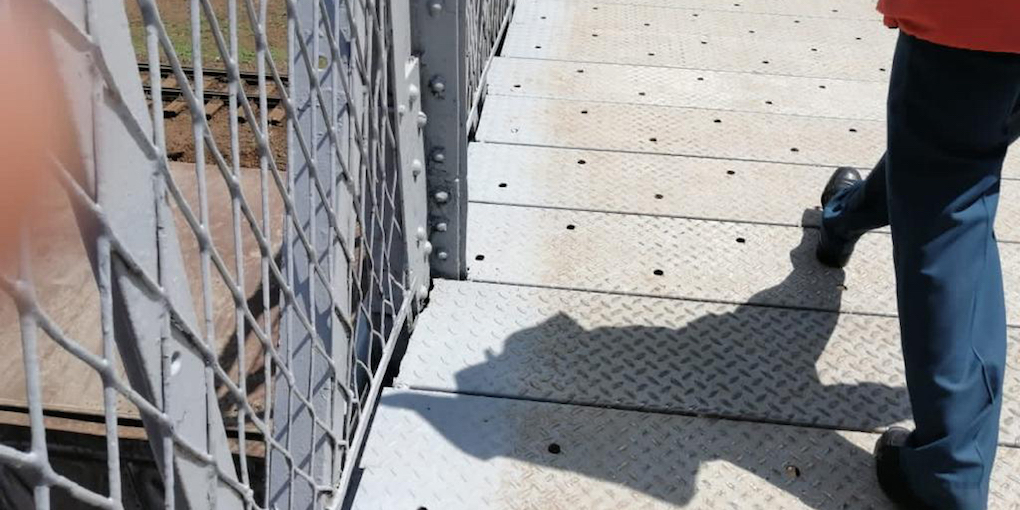
Landi Mawe
by Lutivini Majanja (June 2020)
There’s a footbridge that passes over the Nairobi Railway Station along Workshop Road. I use this bridge to avoid the traffic on Mombasa Road. Better to be walking than sitting in a vehicle, getting agitated at the endless rows of cars, traffic lights, hooting, fruits and all sorts of paraphernalia for sale, watching and listening for the pickpockets, and staring outside through the windows forcedly shut.
At the road from the Nairobi City Square Post Office to that footbridge, I walk at whatever pace I want. Some people rush past, while others walk slowly. There is loud conversation. Parked cars. Respite from Haile Selassie Avenue’s maelstrom. At the Huduma Centre on the ground floor of the post office building, a guard sits next to two mailboxes. They are marked Nairobi and Upcountry. I think about the people who sign letters: mpendwa wako, sincerely, yours faithfully, ni mimi wako, in Christ, your loving child, later, in solidarity, love. Do the recipients notice the considered or clumsy paper and envelope choices? The guard—enclosed in a cell of rope tied to the walkway bollards—directs customers entering and exiting the Huduma Centre.
After the post office further down Workshop Road, students from the Technical University of Kenya mill around their campus. There are vendors along the street intoning handkerchiefs, smokies, boiled eggs with kachumbari, sodas and juice for sale. There is passion juice and fruits for sale. Ahead, on the right, towards the Railway Museum; rhumba music, benga music and multiple aromas emanate from the vibandas. On the left, the quieter side, the Railway Police Station.
Whenever I walk on this footbridge I reminisce about my last long-distance night train ride to Kisumu in December 2007. My then three-year-old niece had learnt a song for the trip.
Gari la moshi linaenda sasa,
na mizigo yake imajaa,
Fika Nyeri, fika Nyeri, ch ch ch ch,
Fika Nyeri, fika Nyeri, ch ch ch ch!
That rhythm lulled us to sleep until daylight in Muhoroni.
At the T-junction linking Workshop Road and Station Road, I climb the smooth worn slanted grey concrete steps to the wooden planks. I wish there was a Keep Left sign on the footbridge, especially for the hours with heavy foot traffic. Between the smooth wooden planks, I see railway tracks. There is garbage piling alongside the parked and retired carriages. After the government banned single-use plastic, this garbage reduced but it remains present. You can smell it sometimes. Every so often, it is cleared away when the grass growing between railway sweepers is slashed. The smell of cut grass. The distressed wooden planks are constantly needing to be replaced. Walking on the footbridge I can see the tall buildings in Upper Hill and the tops of trees are at eye level.
Nairobi is smog-filled, or cloudy, or it is bright and sunny.
Around me, and trudging along are raggedy shoes, block shoes, dust-covered shoes, mud-caked shoes and squeaky sneakers. The footbridge vibrates. When it is windy, the pedestrians’ voices are blown away from their mouths.
What I hear. What I remember hearing. What I miss hearing. What I want to hear. All of that accumulated sound.
In the places where virtual images retire—internet archives, stored prints, dead cell phones—there is a photograph of a fashion model solo strutting on this footbridge, leaning on the handrails and striking a pause. North, south, east and west-facing selfies are continuously generated and shared.
In December 2018, Nairobi’s governor banned matatus from entering the Nairobi Central Business District. There were videos of people squeezed, trampled, spilling and tumbling off this bridge circulating on social media. The ban was lifted to facilitate further consultation with all affected parties, in order to find a lasting solution to the problem of vehicular congestion. Kabich karat, kabich karat, kabich karat….
The constants during my walks are the vendors present on both sides of the bridge. They sell boiled maize or groundnuts, sweets and chewing gum. There’s the bookseller and the vendor with cut sugarcane on a wheelbarrow.
On the other side of the footbridge, you are likely to encounter a musician or two playing an instrument — box guitar, mouth organ, shaker, tambourine, or drum — in tandem with a radio playing choir music. Next to the musicians, bowls for contributions. Inside the bowls, some coins. Maybe a few notes. During the lockdown, there aren’t enough passers-by to feed the musicians’ bowls. Hum.
The road is tarmacked. It is potholed. It is muddy.
A fairly recent addition is the big Executive Toilets sign pointing to the renovated public toilet. It amuses me. What makes a toilet executive? How does an executive use a toilet? A few steps on and it gets difficult to maintain a conversation because the music from the shops — selling shoes and clothes— is loud. The music is bongo flava. The music is gengetone. In December they’ll play Feliz Navidad and other Boney M songs. Daddy Cool is also Christmas music. One year, shops everywhere were booming and selling CDs of Barack Obama’s Yes We Can speech alongside suits, socks, handbags and shirts. The dream. The shopkeepers’ playback, chanting shoes and electronics for sale, is no longer a novelty. You walk past the sounds of hens, chicks, marabou storks and barking dogs.
Here’s a stall specializing in men’s trousers and shirts. Here’s one with bags. Another one selling electronics. Another where you can stop for tea or juice served in a cup sealed with plastic wrap. The engines of the 14-seater matatus facing the roundabout on Bunyala Road urge you to hurry up, get in, and wait.
© 2020 SOUND OF NAIROBI
